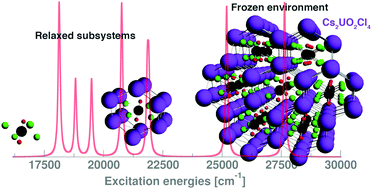Towards systematically improvable models for actinides in condensed phase: the electronic spectrum of uranyl in Cs2UO2Cl4 as a test case†
Abstract
In this work we explore the use of frozen density embedding [Gomes et al., Phys. Chem. Chem. Phys., 2008, 10, 5353] as a way to construct models of increasing sophistication for describing the low-lying electronic absorption spectra of UO22+ in the Cs2UO2Cl4 crystal. We find that a relatively simple embedding model, in which all but the UO22+ unit are represented by an embedding potential, can already describe the main spectral features and the main environment effects can be attributed to the four chloride ions situated at the UO22+ equatorial plane. Contributions from species further away, albeit small, are found to be important for reaching a close agreement with experimentally observed quantities such as the excited states' relative positions. These findings suggest that such an embedding approach is a viable alternative to supermolecular calculations employing larger models of actinyl species in condensed phase. Nevertheless, we observe a slight red shift of the excitation energies calculated with our models compared to experimental results, and attribute this discrepancy to inaccuracies in the underlying structural parameters.


 Please wait while we load your content...
Please wait while we load your content...